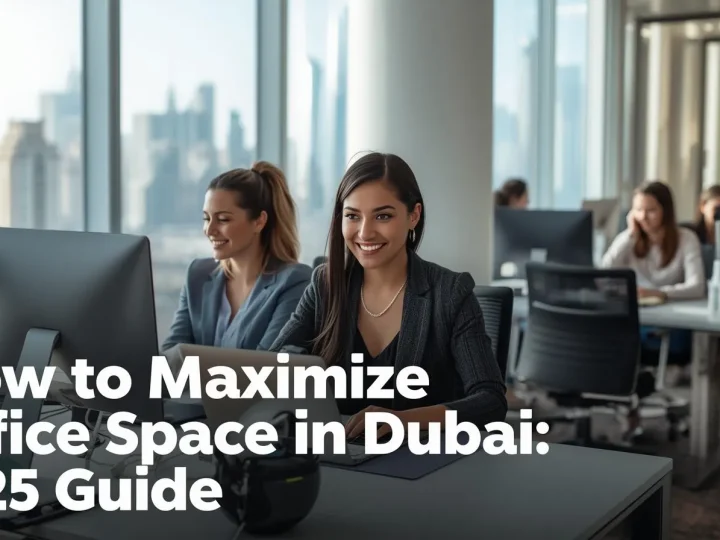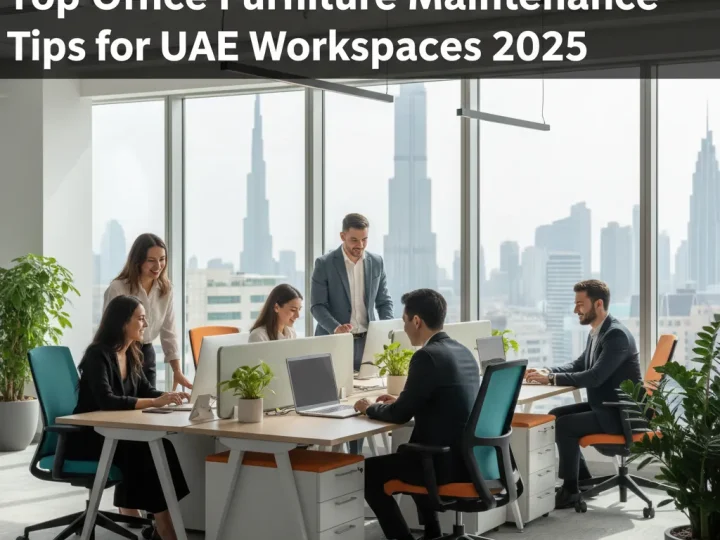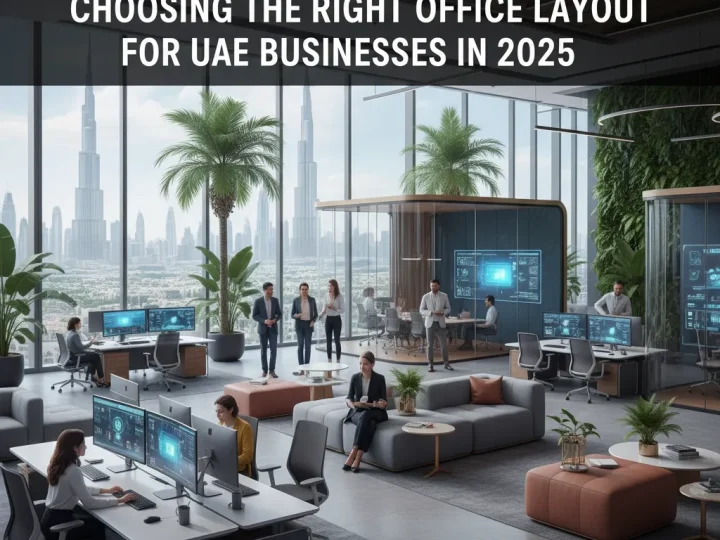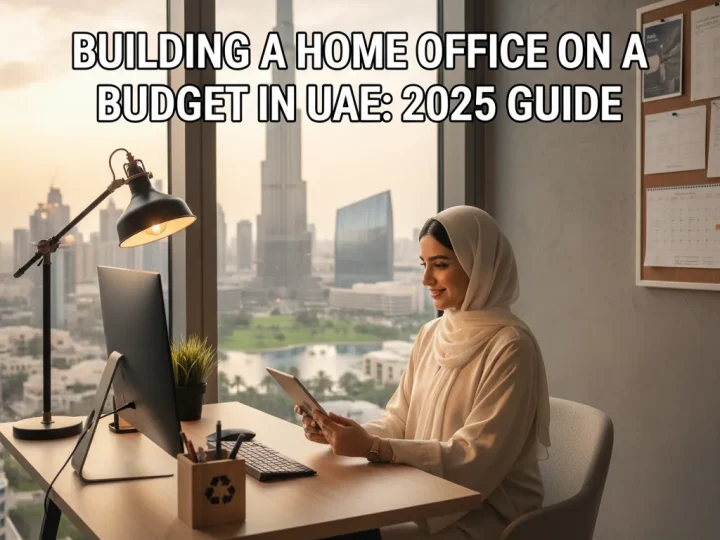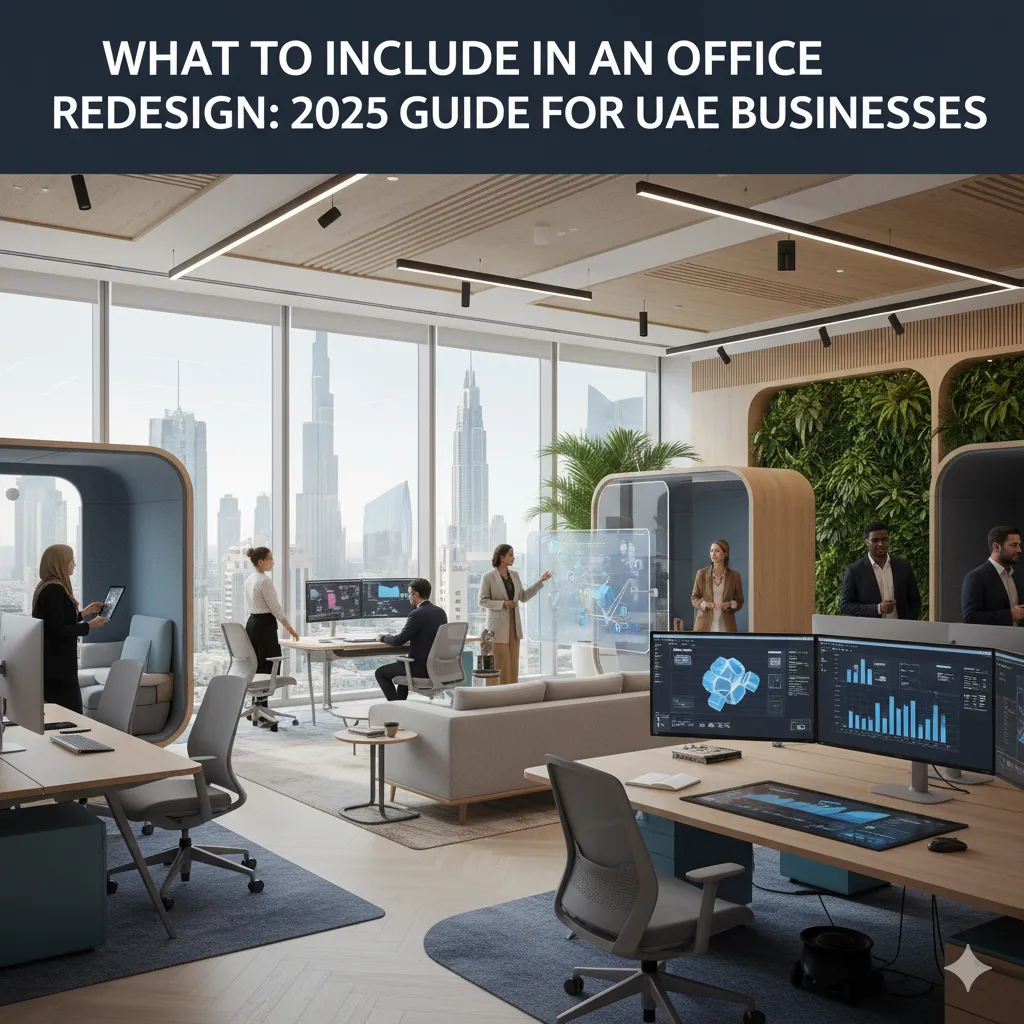
Office spaces in the UAE are changing fast, and what used to be all about desks and chairs now looks completely different. Think about this: offices using eco-friendly furniture materials can cut their carbon footprint by about 22 percent. Most people expect the latest tech or flashiest designs to lead the way, but the real shift is happening where culture, wellness, and technology actually fit together. The question is not what looks good, but what truly works for the people inside those walls.
Table of Contents
- Essential Elements For Modern Office Spaces
- Choosing Office Furniture For UAE Workplaces
- Technology And Smart Features To Consider
- Cultural And Collaborative Design Touches
Quick Summary
| Takeaway | Explanation |
|---|---|
| Flexible Work Environments | Modern office design should prioritize flexibility, offering a variety of workspace options to accommodate different work styles and preferences. This includes creating distinct zones for focused work, collaboration, and relaxation. |
| Technology Integration | Seamless integration of smart technologies is essential for enhancing productivity. Offices should embed IoT features, advanced video conferencing, and collaborative tech to create a supportive work ecosystem. |
| Wellness-Centered Design | Employee wellness is paramount; incorporating biophilic design, ergonomic furniture, and relaxation areas can improve job satisfaction and overall performance. |
| Cultural Sensitivity | Office design in the UAE must balance global trends with local cultural context, respecting traditional dynamics while fostering collaboration through thoughtful layout and design elements. |
| Sustainable Furniture Choices | Selecting eco-friendly furniture is crucial; businesses should focus on sustainable materials and modular designs that reduce waste and reflect corporate social responsibility. |
Essential Elements for Modern Office Spaces
Modern office spaces are transforming from traditional static environments into dynamic, adaptive workplaces that prioritize employee well-being, collaboration, and technological integration. The 2025 workplace demands more than just functional furniture – it requires a holistic approach that considers human psychology, technological needs, and organizational culture.

Flexible and Adaptive Work Environments
Workplace design is moving beyond rigid cubicles and fixed workstations. Explore innovative office solutions that embrace flexibility as a core design principle. Modern offices are implementing modular furniture systems that can be quickly reconfigured to support different work modes – from collaborative team projects to individual focused tasks.
Research from Gensler’s Workplace Survey reveals that high-performing workplaces offer employees multiple workspace options. This means creating distinct zones: quiet areas for concentrated work, open collaborative spaces for team interactions, and comfortable breakout areas for informal discussions. By providing diverse workspace configurations, organizations can accommodate different work styles and preferences.
Technology-Integrated Design
Technology integration is no longer an afterthought but a fundamental aspect of modern office design. Smart offices are embedding technological infrastructure seamlessly into the physical environment. This includes wireless charging stations, integrated power outlets, advanced video conferencing setups, and IoT-enabled environmental controls.
According to Deloitte’s Workplace Technology Report, companies that successfully integrate technology into their workspace design see significant improvements in employee productivity and engagement. The key is creating an ecosystem where technology enhances rather than disrupts work processes.
Wellness-Centered Office Design
Employee wellness has become a critical consideration in modern office redesigns. Beyond ergonomic furniture, this involves creating environments that support physical and mental health. Biophilic design principles are gaining traction, incorporating natural elements like indoor plants, maximizing natural light, and using materials that create a connection with the natural world.
Research from Harvard Business Review demonstrates that workspace design directly impacts employee performance, stress levels, and overall job satisfaction. Elements like adjustable standing desks, acoustic design to minimize noise, and dedicated relaxation zones are becoming standard in progressive office environments.
As businesses in the UAE continue to compete for top talent, office design has become a strategic tool for attraction and retention. The most successful workspaces will be those that balance technological efficiency, human-centric design, and organizational culture.
To help you compare the essential elements discussed above, here’s a summary table outlining their focus and key benefits:
| Element | Main Focus | Key Benefits |
|---|---|---|
| Flexible Environments | Adaptability & Workspace Variety | Accommodates diverse work styles, boosts satisfaction |
| Technology-Integrated Design | Embedded Smart Infrastructure | Increases productivity, smoother collaboration |
| Wellness-Centered Office Design | Employee Physical & Mental Health | Reduces stress, improves performance & retention |
Choosing Office Furniture for UAE Workplaces
Selecting the right office furniture is a critical strategic decision that goes beyond aesthetic appeal. For UAE businesses in 2025, furniture selection represents an investment in employee productivity, workplace culture, and organizational performance.
Ergonomic Considerations and Employee Health
Ergonomic furniture is no longer a luxury but a necessity in modern workplaces. Learn about budget-friendly ergonomic solutions that prioritize employee well-being. According to Corporate Occupational Health Studies, businesses that invest in ergonomic furniture can reduce workplace injuries by up to 35% and improve overall employee productivity.
Key ergonomic features to consider include adjustable chair heights, lumbar support, sit-stand desks, and furniture that supports natural body movements. These design elements help prevent musculoskeletal disorders and reduce long-term health risks associated with sedentary work environments.

Sustainability and Material Selection
Modern UAE workplaces are increasingly prioritizing sustainable furniture solutions. Research from Middle East Sustainability Report indicates that companies using eco-friendly furniture materials can reduce their carbon footprint by approximately 22% and enhance their corporate social responsibility profile.
Sustainable furniture options include:
- Recycled Materials: Furniture made from reclaimed wood, recycled metals, and environmentally friendly composites
- Low-Emission Furniture: Pieces manufactured with minimal volatile organic compounds (VOCs)
- Modular Designs: Furniture that can be easily reconfigured, reducing waste and extending product lifecycle
The following table outlines key sustainable furniture options and their benefits for UAE workplaces:
| Sustainable Option | Description | Key Benefit |
|---|---|---|
| Recycled Materials | Made from reclaimed wood, metals, eco-friendly composites | Reduces resource consumption |
| Low-Emission Furniture | Manufactured with minimal volatile organic compounds (VOCs) | Improves indoor air quality |
| Modular Designs | Easily reconfigurable, extends product lifecycle | Reduces waste & increases flexibility |
Cultural and Functional Adaptability
UAE workplaces require furniture that reflects both local cultural preferences and global design trends. According to Gulf Business Insights, successful office furniture selection balances functionality with cultural sensitivity.
This means choosing furniture that:
- Supports collaborative work styles common in UAE business culture
- Provides flexible spaces for both formal meetings and informal interactions
- Accommodates technological integration seamlessly
- Reflects contemporary design aesthetics while respecting local architectural traditions
Navigating office furniture selection requires a holistic approach that considers employee well-being, sustainability, technological requirements, and cultural context. Businesses that make informed furniture choices will create workspaces that not only look impressive but also drive organizational performance and employee satisfaction.
Technology and Smart Features to Consider
The modern workplace is evolving rapidly, with technology becoming an integral part of office design and functionality. For UAE businesses in 2025, integrating smart technologies is no longer optional but a critical strategy for maintaining competitive advantage and creating an innovative work environment.
IoT and Intelligent Environmental Controls
Explore cutting-edge office innovations that transform traditional workspaces into intelligent ecosystems. Internet of Things (IoT) technologies are revolutionizing office environments by providing unprecedented control and efficiency. According to Gartner’s Smart Workplace Research, IoT-enabled offices can reduce energy consumption by up to 30% through intelligent monitoring and automated systems.
Key IoT features include:
- Smart Lighting Systems: Automatically adjusting brightness based on natural light and occupancy
- Climate Control: Personalized temperature settings for individual workstations
- Occupancy Sensors: Tracking space utilization and optimizing workspace management
Collaborative Technology Infrastructure
Modern offices require robust technological infrastructure that supports seamless collaboration and communication. Research from McKinsey Digital Workplace Report highlights that businesses with advanced collaborative technologies see a 25% improvement in team productivity and communication efficiency.
Critical collaborative technologies include:
- Advanced video conferencing systems with AI-powered noise cancellation
- Interactive digital whiteboards for remote and in-person collaboration
- Cloud-based project management platforms that enable real-time team coordination
Adaptive Workspace Technologies
Emergent technologies are creating more flexible and responsive work environments. Augmented Reality (AR) and Virtual Reality (VR) technologies are transforming how teams interact, design, and solve problems. According to Deloitte’s Technology Trends Report, immersive technologies can reduce design iteration times by up to 40% and enhance spatial planning capabilities.
Innovative adaptive technologies include:
- Mobile robotic partitions that can reconfigure workspace layouts dynamically
- AR-enabled furniture placement and design visualization tools
- Wireless charging stations integrated directly into workstation surfaces
For UAE businesses, technological integration is about creating an ecosystem that enhances human potential. The most successful offices will be those that view technology not as a replacement for human interaction, but as a tool that amplifies creativity, collaboration, and organizational efficiency. By thoughtfully implementing smart technologies, businesses can create workspaces that are not just functional, but truly inspirational.
Cultural and Collaborative Design Touches
Office design in the UAE represents more than functional space planning – it is a nuanced reflection of organizational culture, regional identity, and collaborative potential. Discover human-centered workspace strategies that integrate cultural sensitivities with modern design principles.
Understanding Cultural Context in Workspace Design
UAE workplaces uniquely blend global design trends with local cultural expectations. According to Gulf Business Culture Research, successful office environments must respect traditional Arabic workplace dynamics while embracing contemporary collaborative models.
Key cultural considerations include:
- Respect for Hierarchy: Creating spaces that subtly acknowledge organizational structures
- Privacy Considerations: Designing areas that provide personal space and acoustic separation
- Hospitality Elements: Incorporating welcoming reception and meeting areas reflective of Arabic guest reception traditions
Collaborative Spaces with Regional Sensitivity
Research from Brookings Institution indicates that collaborative spaces must go beyond physical layout to foster genuine interaction. In the UAE context, this means creating environments that encourage both formal and informal communication.
Effective collaborative design strategies include:
- Majlis-inspired informal meeting areas
- Flexible workspaces that support team interactions
- Design elements that facilitate spontaneous knowledge sharing
To offer a concise view of collaborative design strategies with regional sensitivity, the table below summarizes how each approach supports interaction in UAE workplaces:
| Strategy | Regional Influence | Interaction Supported |
|---|---|---|
| Majlis-inspired meeting areas | Reflects Arabic cultural traditions | Encourages informal discussion |
| Flexible team workspaces | Blends global & local styles | Facilitates teamwork & adaptability |
| Knowledge-sharing design elements | Supports UAE innovation culture | Promotes spontaneous communication |
Technology and Human Connection
Successful modern workplaces balance technological integration with human-centric design. A study in Buildings Journal reveals that hybrid workspaces must seamlessly integrate digital and physical environments to support diverse work styles.
Technological considerations for collaborative design include:
- Multilingual digital interfaces
- Video conferencing areas that respect cultural communication norms
- Adaptable technological infrastructure supporting diverse team interactions
For UAE businesses, cultural and collaborative design is not about following global trends, but creating unique workspace ecosystems that reflect organizational identity. The most successful offices will be those that understand design as a strategic tool for communication, innovation, and cultural expression.
Frequently Asked Questions
What are the essential elements for modern office spaces in the UAE?
Modern office spaces in the UAE should include flexible work environments, technology-integrated designs, wellness-centered features, cultural sensitivity, and sustainable furniture choices.
How can ergonomic furniture benefit employees in UAE workplaces?
Ergonomic furniture can reduce workplace injuries by up to 35%, improve employee productivity, and promote overall health by supporting natural body movements and providing adjustable features.
What role does technology play in office redesigns for 2025?
Technology is crucial in modern office redesigns, enabling seamless collaboration, enhancing productivity through IoT applications, and creating smart environments that improve employee engagement.
How can businesses ensure their office design reflects local culture?
To reflect local culture, businesses should incorporate design elements that acknowledge traditional dynamics, create spaces that facilitate both formal and informal interactions, and respect privacy and hierarchy in their layouts.
Transform Your UAE Office into a Future-Ready Workspace
Are you facing the challenge of blending flexible design, smart technology, and employee wellbeing—while still reflecting local UAE culture in your office redesign? Choosing the right partner for your workspace upgrade is crucial if you want to combine ergonomic solutions, sustainable materials, and advanced collaborative tech. Many businesses struggle to find solutions that support productivity without sacrificing comfort or cultural relevance. But the right guidance and product selection can turn a stressful project into a smooth transition for your team.
Take the next step toward a modern, efficient, and customized office environment. Our team at SAGTCO is ready to provide free expert consultation for space planning and tailored office solutions specially designed for UAE businesses. Connect with us now and see how our unique approach can make your 2025 office redesign a true success.
Recommended
- 2025 Office Furniture Budget Tips: Smart Savings Guide – Office Furniture Dubai | Buy Modern Office Furniture Dubai – SAGTCO
- Modern Office Design DUBAI: Inspiring Workspace Trends – Office Furniture Dubai | Buy Modern Office Furniture Dubai – SAGTCO
- 2025 Trending Office Interior Styles: A Complete Guide – Office Furniture Dubai | Buy Modern Office Furniture Dubai – SAGTCO
- Budgeting for Office Furniture 2025 for Dubai Businesses: A Smart Guide – Office Furniture Dubai | Buy Modern Office Furniture Dubai – SAGTCO
- Signage for Office Interiors: 2025 Guide for London Businesses – PromoSigns.co.uk
- The Complete Office Removals Process Guide for 2025 | Schott Removals


